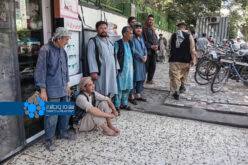One of the reasons for youth migration is poverty and unemployment

Yes, poverty and unemployment are among the most important choices for the migration of Afghan youth. These two factors cause many young people to migrate to other countries in order to find a better life, economic security and stable job opportunities.
The main reason for youth migration is poverty and unemployment:
-
Lack of job opportunities:
- Due to the economic situation of Afghanistan, many young people are able to find a suitable job after graduation or even with technical skills. Unemployment and instability in the labor market force many to leave the country.
-
Poverty and financial resources:
- Many families are unable to meet their basic needs due to extreme poverty. There are young people with this condition, who seek opportunities abroad to socialize with their families.
-
Lack of economic security:
- Economic insecurity caused by political instability and economic crises makes young people hope for a stable future in Afghanistan. This sign of economic security is one of the main drivers for migration.
-
Lack of suitable infrastructure for development:
- Adequate educational and professional facilities, government support for youth, and lack of access to international labor markets lead young people to seek better opportunities abroad.
-
Social and cultural pressure:
- In addition to poverty and unemployment, some young people decide to migrate due to the social and cultural pressures they experience in Afghanistan, legal and social differences.
In general, poverty and unemployment as key factors in the migration of Afghan youth play an important role in the departure of the country’s workforce and elites, which can also have negative effects on the country’s future development.

Increasing poverty in Afghanistan
Poverty in Afghanistan has increased significantly in recent years due to various factors, including war, political developments, economic crisis, and the reduction of international aid. Some of the key factors that have caused the increase in poverty in Afghanistan are:
-
Political crisis and change of government
- After the Taliban took over in August 2021, many government institutions and services were disrupted. Also, the change of government caused the withdrawal of foreign investors and the reduction of international aid to Afghanistan, which had a significant impact on the country’s economy.
- International sanctions against the Taliban also limited the government’s access to foreign financial and commercial resources, which directly affected the country’s economy.
-
Wide unemployment
- Closure of businesses, economic instability, and lack of access to job opportunities have increased unemployment in Afghanistan. Many people have lost their jobs due to insecurity or lack of access to financial resources.
- The reduction of commercial activities and the restrictions imposed on banks have also led to the reduction of job opportunities in various sectors of the economy.
- Drought and climate change
- Afghanistan is one of the countries that has been severely affected by climate change and frequent droughts. Agriculture, which is one of the main sources of income for many families in rural areas, has been severely damaged and has reduced income and food security.
- Lack of water and decrease in agricultural production has led to increase in poverty and economic instability in rural areas.
-
reduction of international aid
- After the Taliban took over, many Western countries and international organizations have cut off or limited their financial and humanitarian aid to Afghanistan. This reduction in aid has had a great impact on Afghanistan’s social, educational and health infrastructure and has led to an increase in poverty.
- Despite some humanitarian aid from international organizations, the needs of the country far exceed the amount received.
-
Increase in prices and inflation
- With the decline in trade and exports and banking problems, the prices of basic goods such as food, medicine, and fuel have increased sharply. This issue has reduced people’s purchasing power and increased poverty.
Many families are barely able to meet their basic needs due to the decrease in income and the increase in living expenses.
- With the decline in trade and exports and banking problems, the prices of basic goods such as food, medicine, and fuel have increased sharply. This issue has reduced people’s purchasing power and increased poverty.
-
Social insecurity and internal migration
- Continuous insecurity and local conflicts have forced many people to leave their homes and seek refuge in other areas. These internal migrants usually face extreme poverty, lack of access to resources and services, and poor living conditions.
As a result, the increase in poverty in Afghanistan has become one of the biggest social and economic challenges and requires serious attention and continuous efforts to improve the economic and social conditions of the country.